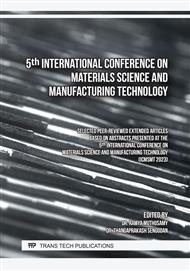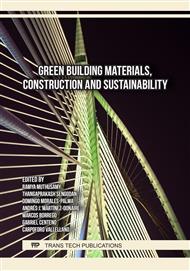[1]
Khater, Hisham & Ezzat, Mohamed & Elnagar, Abdeen. (2016). Engineering of low cost geopolymer building bricks applied for various construction purposes. International Journal of Civil Engineering and Technology. 7. 81-99.
Google Scholar
[2]
Sanjayan, Jay & Nazari, Ali & Chen, Lei & Nguyen, Giang. (2015). Physical and mechanical properties of lightweight aerated geopolymer. Construction and Building Materials. 79.
DOI: 10.1016/j.conbuildmat.2015.01.043
Google Scholar
[3]
Patcharapol Posi, Chaiyapong Teerachanwit, Chatchai Tanutong, Suttikait Limkamoltip, Surasit Lertnimoolchai, Vanchai Sata, Prinya Chindaprasirt, Lightweight geopolymer concrete containing aggregate from recycle lightweight block, Materials & Design (1980-2015), 52, 2013, pp.580-586, ISSN 0261-3069.
DOI: 10.1016/j.matdes.2013.06.001
Google Scholar
[4]
Ramin Hosseini Kupaei, U. Johnson Alengaram, Mohd Zamin Bin Jumaat, Hamid Nikraz, Mix design for fly ash based oil palm shell geopolymer lightweight concrete, Construction and Building Materials, 43, 2013, pp.490-496, ISSN 0950-0618.
DOI: 10.1016/j.conbuildmat.2013.02.071
Google Scholar
[5]
Bassam A. Tayeh, Ahmad Hakamy, Mohamed Amin, Abdullah M. Zeyad, Ibrahim Saad Agwa, Effect of air agent on mechanical properties and microstructure of lightweight geopolymer concrete under high temperature, Case Studies in Construction Materials, 16, 2022, e00951, ISSN 2214-5095.
DOI: 10.1016/j.cscm.2022.e00951
Google Scholar
[6]
William D.A. Rickard, Arie van Riessen, Performance of solid and cellular structured fly ash geopolymers exposed to a simulated fire, Cement and Concrete Composites, 48, 2014.
DOI: 10.1016/j.cemconcomp.2013.09.002
Google Scholar
[7]
Meesala, CR, Verma, NK, Kumar, S. Critical review on fly-ash based geopolymer concrete. Structural Concrete. 2020; 21: 1013– 1028.
DOI: 10.1002/suco.201900326
Google Scholar
[8]
Shengnian Wang, Qinpei Xue, Yin Zhu, Guoyu Li, Zhijian Wu, Kai Zhao, Experimental study on material ratio and strength performance of geopolymer-improved soil, Construction and Building Materials, 267,2021,120469.
DOI: 10.1016/j.conbuildmat.2020.120469
Google Scholar
[9]
Kupwade-Patil, Kunal and Erez N. Allouche. "Effect of Alkali Silica Reaction (ASR ) in Geopolymer Concrete." Material Science (2011).
Google Scholar
[10]
Gökhan Kaplan, Ali Öz, Barış Bayrak, Haluk Görkem Alcan, Oğuzhan Çelebi, Abdulkadir Cüneyt Aydın, Effect of quartz powder on mid-strength fly ash geopolymers at short curing time and low curing temperature, Construction and Building Materials, 329, 2022, 127153, ISSN 0950-0618
DOI: 10.1016/j.conbuildmat.2022.127153
Google Scholar
[11]
Hemn Unis Ahmed, Azad A. Mohammed, Ahmed S. Mohammed, The role of nanomaterials in geopolymer concrete composites: A state-of-the-art review, Journal of Building Engineering, Volume 49, 2022, 104062, ISSN 2352-7102.
DOI: 10.1016/j.jobe.2022.104062
Google Scholar
[12]
M.C.G. Juenger, F. Winnefeld, J.L. Provis, J.H. Ideker, Advances in alternative cementitious binders, Cement and Concrete Research, 41(12),2011, pp.1232-1243, ISSN 0008-8846.
DOI: 10.1016/j.cemconres.2010.11.012
Google Scholar
[13]
Pradip Nath, Prabir Kumar Sarker, Flexural strength and elastic modulus of ambient-cured blended low-calcium fly ash geopolymer concrete, Construction and Building Materials, 130, 2017, pp.22-31, ISSN 0950-0618.
DOI: 10.1016/j.conbuildmat.2016.11.034
Google Scholar
[14]
Ankur Mehta, Rafat Siddique, Togay Ozbakkaloglu, Faiz Uddin Ahmed Shaikh, Rafik Belarbi, Fly ash and ground granulated blast furnace slag-based alkali-activated concrete: Mechanical, transport and microstructural properties, Construction and Building Materials, 257, 2020, 119548, ISSN 0950-0618.
DOI: 10.1016/j.conbuildmat.2020.119548
Google Scholar
[15]
Anjana Elsa Alexander, A.P. Shashikala, Studies on the mechanical and durability performance of textile reinforced geopolymer concrete beams, Materials Today Communications, 35, 2023, 105837, ISSN 2352-4928.
DOI: 10.1016/j.mtcomm.2023.105837
Google Scholar
[16]
Antonella Petrillo, Raffaele Cioffi, Claudio Ferone, Francesco Colangelo, and Claudia Borrelli. "Eco-sustainable Geopolymer Concrete Blocks Production Process" Agriculture and Agricultural Science Procedia, vol. 8, 2016. https://
DOI: 10.1016/j.aaspro.2016.02.037
Google Scholar
[17]
IS 2386:1968, Specification for coarse and fine aggregates from natural source for concrete.
Google Scholar
[18]
IS 3812-1: Specification for Pulverized Fuel Ash, Part 1: For Use as Pozzolana in Cement, Cement Mortar and Concrete
DOI: 10.3403/00138738
Google Scholar
[19]
IS 15658 : 2006 Precast concrete blocks for paving, Bureau of Indian Standards, New Delhi, India.
Google Scholar
[20]
IS 456: 2000 Plain and Reinforced Concrete - Code of Practice, Bureau of Indian Standards, New Delhi, India.
Google Scholar
[21]
C. Vivek Kumar, M. Palanisamy, C. Balakrishna, S. Pooja Sri Reddy, S. Robert Ravi, Evaluation of strength characteristics and identifying the optimum dosage with the impact of partial replacement of recycled fine and coarse aggregate from construction and demolition waste, Materials Today: Proceedings, 66(4), 2022, Pages 1699-1709, ISSN 2214-7853.
DOI: 10.1016/j.matpr.2022.05.265
Google Scholar
[22]
A.N. Swaminathen, C. Vivek Kumar, S. Robert Ravi, Sohang Debnath, Evaluation of strength and durability assessment for the impact of Rice Husk ash and Metakaolin at High Performance Concrete mixes, Materials Today: Proceedings, 47(14), pp.584-4591, ISSN 2214-7853
DOI: 10.1016/j.matpr.2021.05.449
Google Scholar
[23]
Swaminathen, A. N. et al. "Use of Rice Husk Ash and Metakaolin as Pozzolonas for Concrete: A Review." (2016).
Google Scholar
[24]
P Magudeaswaran, Vivek Kumar C, K Vamsi Krishna, Akella Nagasaibaba, Rathod Ravinder, Investigational studies on the impact of Supplementary Cementitious Materials (SCM) for identifying the strength and durability characteristics in self curing concrete, Materials Today: Proceedings, 2023, ISSN 2214-7853.
DOI: 10.1016/j.matpr.2023.03.161
Google Scholar



